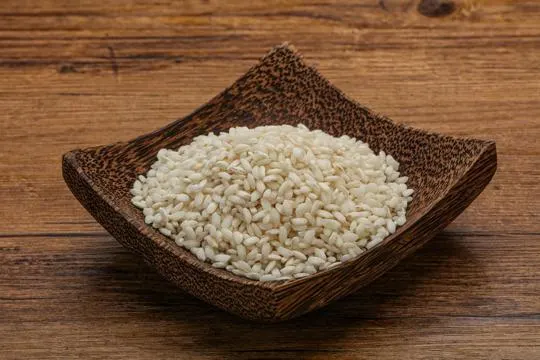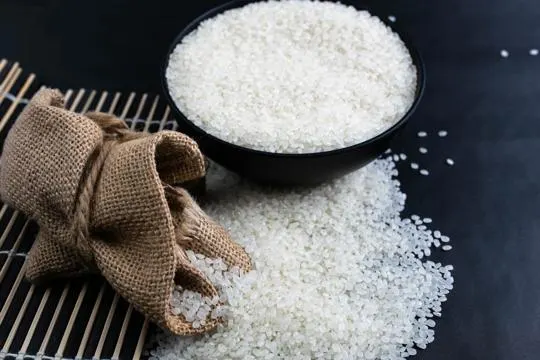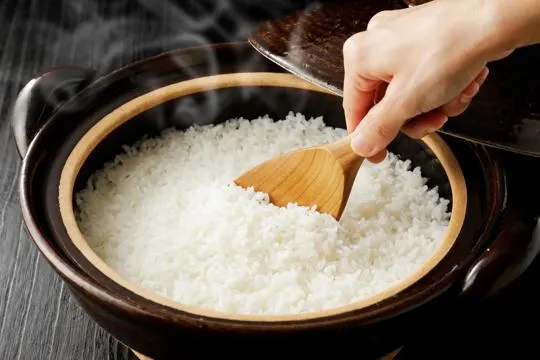Rice is a staple. Two types often spark confusion: Arborio and Sushi rice.
Arborio, the star of risotto, has a superpower: it turns creamy while cooking. Sushi rice, on the other hand, sticks together, making it perfect for rolling up with your favorite fillings.
Our kitchens have seen it all. We’ve had our share of sticky situations and creamy messes.
In this showdown, we’re laying down the facts, plain and simple. No fluff, just the good stuff.
Rice isn’t just rice. The difference? It’s in the grain.
What is Arborio Rice?

Arborio rice is renowned in Italian cooking for its creamy texture and flavor-absorbing quality.
It’s named after a town in Italy’s Piedmont region.
The high starch content makes it a popular choice for risotto, a dish that requires stirring to release its starch for that creamy consistency.
The chewy grains have a pearly look and can take in lots of liquid without becoming mushy.
Plus, the subtle nutty flavor of Arborio rice makes dishes tastier.
It’s often paired with mushrooms, Parmesan cheese, peas, or seafood.
It’s not just for Italian cuisine; Arborio rice can be used in various international recipes.
From pilaf and stir-fries to desserts like rice pudding, it’s an ideal choice for its ability to absorb flavors.
What is Sushi Rice?

Sushi rice is a must-have for Japanese cooking.
It’s a short-grain white rice with a sticky texture.
When cooked, the grains stick together firmly so they hold when rolled into sushi.
This makes it perfect for shaping and forming sushi rolls.
It’s usually seasoned with a mix of rice vinegar, sugar, and salt.
This gives it a sweet, tangy taste that goes well with the fresh ingredients in sushi.
Its absorbing qualities make it an essential part of the sushi experience.
Sushi rice is versatile and adds a great element to the taste and texture of sushi dishes.
Differences Between Arborio Rice and Sushi Rice

Arborio & sushi rice have distinct features.
Understanding these differences is essential when choosing the right type of rice.
Grain Size and Shape
Grain size and shape are key in distinguishing arborio rice from sushi rice.
Arborio is short and plump, renowned for its starchiness.
Sushi rice has small, round grains that stick together when cooked.
This is what gives dishes their texture and consistency.
Arborio is perfect for creamy risotto recipes.
Its starch content allows it to take in more liquid.
The result? A velvety texture and a thick sauce-like consistency.
Arborio also releases starch slowly when cooked, coating each grain nicely.
Sushi rice’s grains are small and round.
When molded into nigiri and rolled into sushi rolls, these grains remain compact.
The sticky nature of sushi rice helps it keep together, even when sliced or dipped into soy sauce.
This stickiness is paramount for the classic bite and taste of sushi.
The primary difference between these two types of rice is grain size and shape.
Knowing this will transform your culinary creations.
Starch Content and Texture
Rice is a much-loved food all over the world.
There are two types of rice which are Arborio and sushi rice.
They are different due to their starch content and texture.
Arborio rice has a high-starch content.
This makes it great for Italian dishes, like risotto, as it gives the dish creaminess and an al dente texture.
The grains are also plump and can absorb flavors.
Sushi rice has a lower starch content.
This is why it is perfect for Japanese cuisine, like sushi rolls.
It has a stickier texture which holds together when rolled or shaped.
Arborio rice is unique as the high-starch content releases gradually during cooking, resulting in a creamy consistency.
Sushi-zu is a special preparation method used for sushi rice.
This involves adding vinegar, sugar, and salt to freshly cooked rice.
These flavors give the rice its sticky character and enhance its taste.
Cooking Method and Application
Arborio rice and sushi rice are cooked differently.
Arborio is used in risotto and has a creamy texture due to its ability to absorb liquids and release starch.
It has short, plump grains for a chewy consistency.
Sushi rice is stickier and has a special vinegar seasoning.
It’s firmness allows it to be shaped into nigiri or maki rolls.
Each type of rice is great for different recipes.
Flavor and Taste
Arborio rice has a nutty flavor and a slightly chewy texture.
It’s great for dishes like risotto.
Sushi rice has a subtle sweet and tangy taste.
Plus, it’s sticky so it works well in sushi rolls.
Each type of rice has its own appeal.
So, it depends on your flavor preference and your culinary vision – Arborio or sushi rice?
Similarities Between Arborio Rice and Sushi Rice

Arborio rice and sushi rice may look different, but they’ve got some things in common.
Both have a sticky texture and hold on to flavors.
They’re great for dishes needing that stickiness, like risotto or sushi.
Arborio rice is used in Italian cuisine, especially risotto.
It has lots of starch, which makes it creamy when cooked.
Sushi rice is a short-grain variety which also gets sticky.
That’s why it’s perfect for sushi rolls.
Both arborio and sushi rice absorb flavors easily.
Arborio is cooked with broth or wine for added flavor.
Sushi rice is seasoned with vinegar, sugar, and salt, which gives it a tangy taste that goes with the other ingredients.
Though there are similarities, each type of rice has its own special qualities too.
Arborio has more starch, so it’s great for creamy dishes.
And sushi rice has a subtle sweetness from the seasoning used in cooking.
Popular Dishes Made with Arborio Rice and Sushi Rice
Arborio and sushi rice are often used in yummy dishes, showcasing their versatility.
These two types of grains have their own distinct characteristics and flavors, adding to the variety of worldwide cuisines.
Risotto is a famous dish made with Arborio rice.
It stands out for its creamy texture and delicious taste.
This type of rice has short, round, starchy grains that absorb liquids and soft ingredients while staying firm.
When cooked with different ingredients like broth, cheese, wine, or veggies, Arborio turns into a yummy risotto.
On the contrary, sushi rice is an essential part of traditional Japanese sushi rolls.
It is made by mixing freshly cooked short-grain rice with vinegar, sugar, and salt.
This combination results in sticky yet flavorful rice that holds its shape when rolled.
The mix of vinegared sushi rice with raw fish or vegetables is the basis of this popular dish.
Although both Arborio and sushi rice provide great culinary experiences, they differ in texture and flavor.
Arborio is creamier due to its starch content, while sushi rice has a slightly sweet and tangy flavor thanks to the vinegar.
How to Cook Arborio Rice and Sushi Rice?
Cooking Arborio and sushi rice needs unique techniques.
Arborio, used in risotto, must be cooked slowly – stirring it all the while to give it a creamy texture.
But sushi rice requires rinsing and then the absorption method, where the water is absorbed without stirring.
For Arborio, start by sautéing in butter or oil for a few minutes.
Then add hot broth or stock while stirring constantly.
This breaks down starches and gives it a creamy consistency.
The final result should be tender yet firm grains.
Sushi rice needs a different approach.
Rinse it with cold water until the water runs clear.
Let it drain for 30 minutes.
Put the rice and cold water in a pot (1:1) and boil over medium-high heat.
Then reduce heat and cover pot.
Simmer for 15-20 minutes until all water is absorbed.
After cooking, rest for 5 minutes before fluffing gently with a fork or paddle.
This distributes moisture evenly throughout each grain.
In conclusion, Arborio and sushi rice need special techniques.
Arborio is cooked slowly with stirring.
And sushi needs the absorption method to be sticky.
Conclusion
After reading this article, it is clear that the differences between arborio and sushi rice are numerous.
While both grains are of Italian origin, their production process, texture, and flavor profile differ greatly.
The result of these distinctions create two distinct types of food products when cooked.
Arborio rice is ideal for cooking risotto due to its short-grain nature and high absorption capability.
Conversely, sushi rice has a slightly sweet flavor and stickiness making it perfect for creating mouthwatering sushi rolls.
Ultimately, both arborio and sushi rice offer unique culinary experiences depending on your preference.

Leave a comment